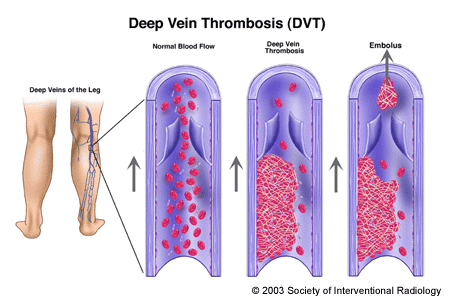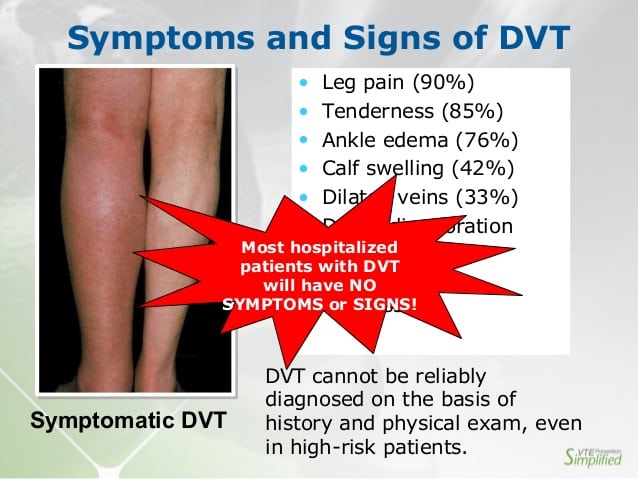Veins provide the essential networks that allow blood to flow throughout the body. As blood moves through veins between the heart and extremities, any type of blockage or impairment can have a significant effect on a person’s overall health. Vein disease presents itself in a variety of forms, but one that patients are regularly advised to be on the lookout for is Deep Vein Thrombosis (DVT).


Understanding DVT
DVT occurs when a blood clot is formed within veins that are nestled generally more deeply within the human body. It’s extremely common for deep vein clots to appear in the thighs and lower legs. Factors that increase the likely hood of DVT include trauma such as an injury or surgery, immobility that often occurs with long-distance travel or illness, smoking, cancer, and inherited clotting disorders. Other risk factors that slightly increase the risk of developing a DVT include faulty valves within the vein network as well as varicose veins that have been left untreated when looking at why a deep vein blood clot might form in these areas. The risks associated with DVT are many and often, rather severe. In the event that a blood clot breaks loose, there is the risk that an individual may suffer a pulmonary embolism, stroke, or heart attack.
Signs and Symptoms Associated with DVT
While having a physician diagnose DVT is always the ideal scenario, understanding the potential signs and symptoms early on is a great way for a patient to take preventative steps before an appointment is even scheduled. Symptoms associated with DVT tend to revolve around increased warmth and tenderness over the affected area. This is often accompanied by pain and swelling in the body where the blood clot has developed and often the skin in this area will be tinged with a red hue. Individuals suffering from DVT will often also experience ankle edema, dilated veins, and swelling of the calves which is often a prime indicator that it’s time to see a physician.
The Benefits of Early Diagnosis and Deep Vein Thrombosis Treatment
Because DVT is often closely linked to vein disease that’s simply been overlooked or ignored, it’s important to establish care with a physician who is focused on treating the disease that could potentially lead to DVT down the line. In many cases, treating underlying vein disease doesn’t have to be a difficult, painful, or intimidating process for patients and can help make sure health stays intact over the long-term. Benefits associated with vein disease treatment are many. Treatment options in the modern world of health care are quick and effective and can often utilize laser technologies that reduce recovery time significantly. Where once upon a time painful vein stripping was turned to as the primary treatment option for vein disease, modern medicine offers up a wide variety of options that eliminate painful processes and keep efficiency and safety a top priority.
Safety Considerations
Many patients hesitate to undergo treatment for vein disease hoping to avoid any major surgery that involves general anesthesia and all of its associated risks. Fortunately, advances in modern medicine and cosmetic services mean patients can now enjoy picking and choosing from treatment options that fit their health goals and preferences and that often exclusively incorporate only local anesthesia. This keeps the entire process more comfortable and more importantly, safe for patients who may be more sensitive to anesthetic interventions. In addition to local anesthesia, many cosmetic physicians now prefer to take a more comprehensive step-by-step treatment plan approach in order to ensure all aspects of potential vein disease are taken into account and the most successful results are achieved.
Insurance Options and Financial Coverage
As with so many cosmetic and health procedures, the final price tag linked to vein disease and DVT treatment will vary from patient to patient depending on the severity of treatment area and the number of treatment sessions required to achieve successful results. Fortunately, many non-cosmetic vein treatment options are covered by insurance policies and to that end, it’s essential that patients check with their insurance provider prior to undergoing any form of treatment. In the event that insurance doesn’t cover the cost of care, the team at the St. Louis Laser Vein Center is happy to work with patients to come up with an in-house financing plan that works with your budget, timeline, and needs.
Schedule a Consultation Today
When it comes to comprehensive vein care, Dr. Wright and his team at the St. Louis Laser Vein Center have the experience, passion, and precision to make sure you achieve the results you deserve and desire. The first step in establishing a customized treatment plan is to schedule a consultation with Dr. Wright. After a thorough medical review and opportunities to answer questions and address concerns, Dr. Wright will put a personalized plan of action into place that guarantees every one of our patients feels safe, welcome, and comfortable with the process from start to finish. Contact us today for more information on our many vein disease and DVT treatment options.
Benefits of Vein Treatment at the Laser Vein Center
- HEALTHIER LOOK AND FEEL TO YOUR LEGS
- ONLY LOCAL ANESTHESIA IS USED, INCREASING THE PROCEDURE’S SAFETY
- QUICK AND EFFECTIVE CUTTING EDGE LASER TECHNOLOGIES USED
- QUICK TO NO RECOVERY TIME
- COMPREHENSIVE STEP-BY-STEP PROCESS ENSURES THE BEST RESULTS
- NON-COSMETIC VEIN TREATMENT IS COVERED BY MOST INSURANCE POLICIES
- MULTIPLE SAFE TREATMENT OPTIONS AVAILABLE
- CONTACT DR. WRIGHT TODAY TO LEARN MORE!
